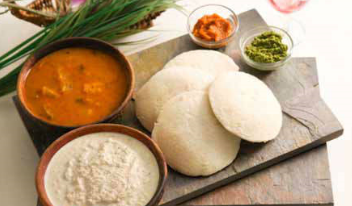Idli: Tamil-Udupi Cuisine
This is a collection of articles archived for the excellence of their content. Readers will be able to edit existing articles and post new articles directly |
Contents |
Idli
How to prepare idli mix at home
Here's how you can go about it:
Ingredients
Urad flour: 50 gms Idli rawa or idli sooji: 225 gms Water: 500 700ml Salt to taste
Method
Fetch urad flour available at any flour mill near your area. Flour mills usually stock idli sooji also. So this makes your shopping for the basic ingredients simpler. In a large vessel, take the urad flour, add the idli rawa followed by two to three tsp of salt. Mix the ingredients very well. Add water and mix well so that a batter with the desirable consistency is formed. If you think the batter needs more water, then add some 100 ml water more. But do not make it too watery. Keep the batter aside for about 10 15 hours. A dry idli mix takes longer to ferment because the ingredients are not soaked before the batter is prepared. So it takes couple of hours longer for the batter to rise. Once the batter is ready, you can steam cook the idlis as many as you like and serve these along with sambar and different types of chutnies.
Benefits
A fight against mineral deficiency
B S Satish Kumar, Idli, dosa help fight mineral deficiency, October 13, 2017: The Hindu
For vegetarians, a south Indian diet enables higher absorption of iron, says study
Those with a weakness for south Indian food now have a legitimate reason to gorge themselves on idlis and dosas: these dishes help in the body’s absorption of minerals such as iron and zinc.
A large number of Indians have trouble absorbing iron and zinc from food. While this is mainly due to vegetarian food habits, south Indian vegetarians are better off: their food choices allow for better absorption of iron and zinc, says a study published last month in Current Science by scientists of the Indian Institute of Horticultural Research.
The article says the high content of phytates (anti-oxidants in cereals, legumes and oilseeds) in Indian foods slows down the absorption of iron and zinc. This causes deficiencies even in people whose diet may contain abundant quantities of these minerals.
“Despite sufficient availability of iron and zinc in the form of food, there is widespread deficiency of these minerals. We are mainly a vegetarian nation and the phytate content of vegetarian diets is high. This may be the main cause for the low absorption of iron and zinc,” says the article authored by A. N. Ganeshamurthy, D. Kalaivanan and B. L. Manjunath.
The paper suggests that research efforts should focus on bioavailability (absorption by the body) rather than biofortification, as food sources already supply enough iron and zinc. “Methods available for reducing the phytic-acid content of Indian foods…should find a prime place in nutritional programmes,” the research paper says.
Dr. Ganeshamurthy told The Hindu that the absorption efficiency of these minerals among most Indians eating phytate-rich foods was below 10%. It should rise to 25% and above, he said. This does not mean that people should quit vegetarian food, but they should adjust diets to reduce phytates.
Fermentation helps
The article said people who primarily consume south Indian vegetarian food, dominated by dishes such as idli, dosa and sprouts, can absorb iron and zinc effectively. This is because these have undergone fermentation, soaking, and germination, which reduces phytates, leading to enhanced bioavailability. The problem of phytates could also be overcome, the paper suggests, by eating fruits like guava and amla, and meat, poultry or fish.
Breakfast recipe for diabetics: Moong idlis
Ingredients
Parboiled rice 1/2 cup Poha ½ cup Whole Green Moong 1 cup Sprouted methi seeds 2 tsp or methi seeds 1 tsp Grated Carrot ¼ cup Finely chopped cabbage ¼ cup Chopped coriander leaves 2 tbsp Chopped green chillies 1 tbsp Salt to taste
Method
1. Soak rice and dal overnight. Sprinkle enough water on poha to soften it. Grind together with sprouted methi seeds. 2. Allow to ferment by keeping aside overnight. Smear a little oil on idli moulds. 3. Mix in the grated carrots, cabbage, green chillies and coriander leaves. 4. Add enough salt and mix well. Pour on to the greased idli moulds. 5. Steam cook for 78 minutes or until done. Serve hot with sambar and mint or tomato chutney
Healthy snack: Instant idli in 30 minutes
This recipe is very healthy as the main ingredients are not rice and urad daal. Instead, it is made from simple and fresh ingredients. This healthy snack can be served with coconut chutney or sambhar. Time taken 30 mins Yields 16 idlies Preparation time 2 mins Fermenting time 15 20 mins Cooking time 810 mins Level Super rasy
Ingredients
1 and a half cup of Suji/ Rawa/ Semolina Curd 1/2 cup or less Water little Salt 1 tsp or more Oil 1 tsp (optional) Soda bi carbonate half of 1/4th tsp or 1 fat pinch
Method
Wash and rinse the rawa for 34 times, so that the dusty starchy particles are washed away. There will be some water remaining, to which you can add curd, salt and soda bicarbonate. The batter should be in flowing consistency. In case it is thick, add a little water to it Let it rest for 1520 minutes to ferment. After 20 minutes steam the idlies in a well greased mould for 810 minutes. Remove from mould and once cooled enjoy it with warm sambhar or coconut chutney.


